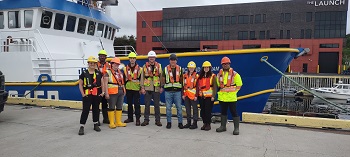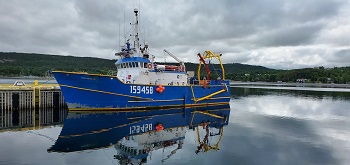News
Thursday, September 7, 2023
Some enthusiastic Marine Institute (MI) students spent several weeks in the field this summer — or, more accurately, on the water.
In collaboration with Fisheries and Oceans Canada (DFO), MI researchers and students completed the second at-sea mission of a five-year research project to monitor species and their activity in marine conservation areas off Newfoundland and Labrador.
Marine conservation areas help protect important species, habitats, and ecosystem, including unique and significant aggregations of corals, sponges and species of cultural and economic importance.
The team was aboard the Patrick and William, a converted fishing vessel turned floating research lab, for two legs: from July 8–27 and July 27–Aug. 6.
The crew travelled to Hawke Channel in the Newfoundland-Labrador Shelves Bioregion and Funk Island Deep: located northeast of Fogo Island. At both sites, they performed non-invasive techniques to monitor species and water column characteristics in the protected areas.
Under the direction of Dr. Jonathan Fisher, chief scientist and researcher at the Marine Institute’s Centre for Fisheries Ecosystems Research, the team conducted activities at 44 stations, with depths from 180–560 metres. They performed 215 science operations in addition to multi-beam mapping of the sea floor and fisheries acoustics mapping of the water column.
Nadine Templeman, marine conservation operations lead, DFO-N.L. region, says the project resulted in enhanced collaboration between Fisheries and Oceans Canada and the Marine Institute.
“We are making great strides in advancing ocean science and management objectives, specifically with regard to marine conservation areas monitoring, research and community engagement,” she said. “Last year was highly successful for both organizations with collective accomplishments far exceeding those able to be achieved with otherwise parallel activities.”
Graduate and undergraduate students from the Marine Institute’s ocean mapping, ROV, fisheries science and marine environmental programs participated in various activities while at sea.
These research tasks included sea floor mapping, gathering footage of bottom communities, physical and biological oceanographic sampling, water column characterization, species identification, and opportunistic seabird and marine mammal observation.
The team employed acoustics, multi-beam, drop-drift and baited video cameras, bongo nets, profilers, ROV technologies and an eDNA sampler.
Environmental DNA (eDNA) is a key element for the project; it’s the process by which DNA molecules are extracted from collected water samples and analyzed to inform researchers of species present in the area.
This year, 164 eDNA samples were collected.
Robyn Whelan, a bachelor of technology student, returned to the project for the second year. She was responsible for conducting the eDNA sampling on the first leg of the trip.
“This included cleaning the eDNA laboratory of any potential contamination, collecting the water samples and filtering the water samples to capture the eDNA onto a filter,” she said.
While stationed at Funk Island Deep, fisheries science graduate student Gordon de Jong led the eDNA collection. It was his first time travelling offshore.
“There are many challenges associated with collecting samples on a boat that I learned about for the first time,” said Mr. de Jong.
Observations made in the marine conservation areas came in all sizes, from the very tiny — zooplankton collected from bongo nets at 60-metre depths in Hawke Channel — to the very large, such as humpback whales sighted in Funk Island Deep.
For the second year in a row, a Greenland shark was observed. The team also identified threatened species such as the spotted wolf fish.
The team made several adjustments to be more sustainable, based on experiences and findings from last year.
During previous trips, the team noticed that eDNA sampling was generating a significant amount of plastic waste.
This year’s used plastic will be sent to TerraCycle, an innovative recycling company that melts used plastic into pellets, generating new products.
First-year findings
Results from last year are still being analyzed, but some early results have been summarized.
Throughout their three stops, eDNA analysis identified 265 species. The baited camera collected 70 hours of footage across nine stations and led to the identification of 14 vertebrate and invertebrate taxa.
The team also recorded all data on station ID, taxa, individual counts, bottom type, depth, temperature, co-ordinates, processor notes and their associated screen grabs. Ocean mapping efforts from 2022 yielded about 1,550 square kilometres of mapped data.
Follow the team
To document their experiences, marine environmental student Hannah Steele, with the assistance of those on board, created the At Sea blog, detailing the team’s experiences.
Highlights from the trip included the biodiversity observed on the sea floor in Hawke Channel and the numerous whales, porpoises and other sea life observed first-hand.
Ocean mapping students Kasun Perera and Kavindu Deraniyagala tracked the vessel movements and generated a story map to connect last year’s activities to the 2023 mission.





